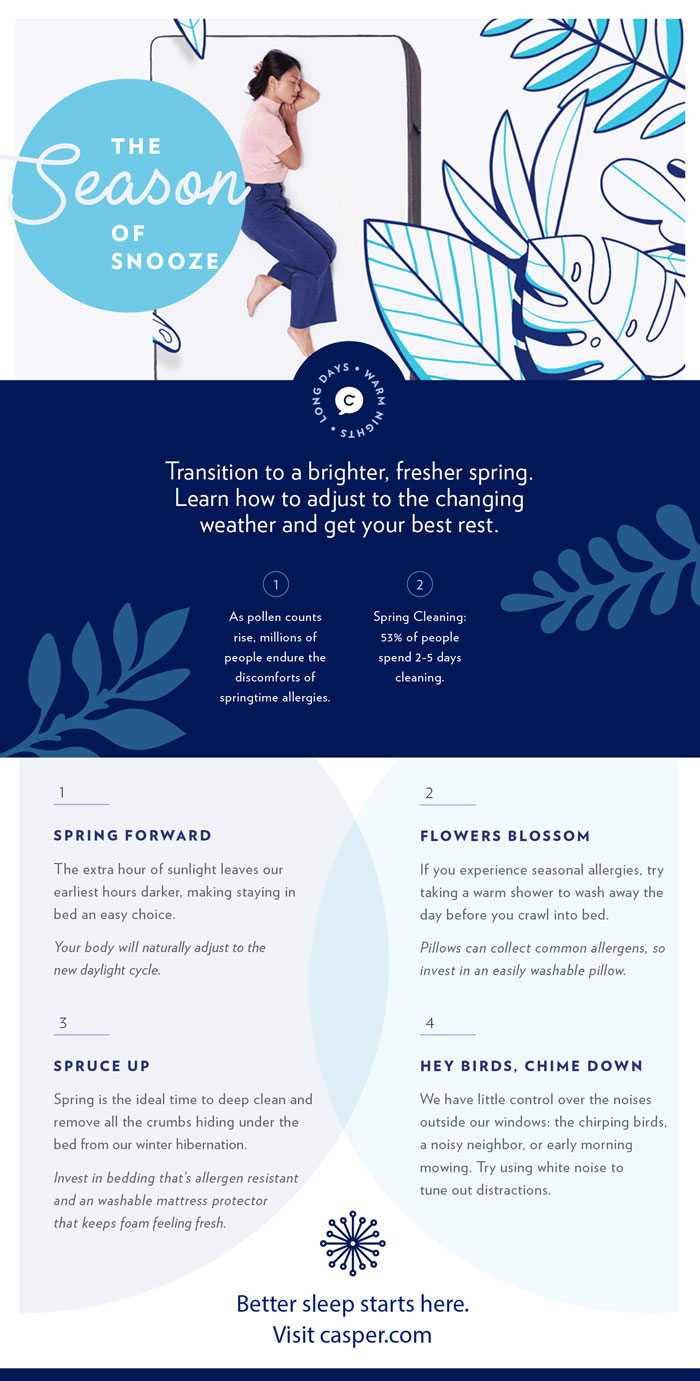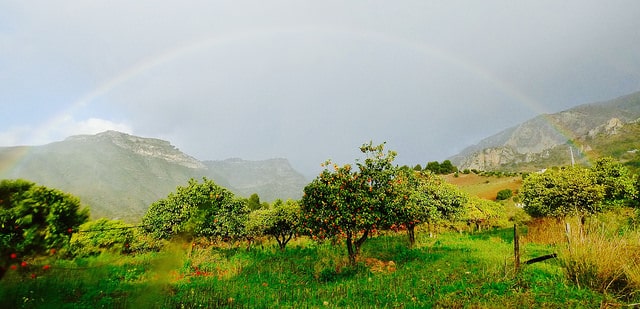
Environmentally Friendly Ways to Prepare Your Home for Spring

Winter is a beautiful season. For many, the snow is a time to enjoy the outdoors, while for others, it’s a time to cozy up by the fire. Even as an avid winter-lover, however, the first day of spring always brings a smile. A warm breeze. Blue sky. Birds chirping. It’s the season of life, rebirth, and growth. As a transitional season, it’s also the perfect opportunity to refresh your space and embrace the changes in weather.
In this article, we’ll discuss ways to prepare your home for spring while keeping your environmental impact in mind.
Cleaning Up
It is natural to feel the urge to spring-clean. The fresh air motivates us to open our spaces which often reveals the dirt, dust, and crumbs we’ve overlooked during our winter hibernation. Plus, there’s nothing more motivating than the spring sunshine showing off all the dust on our blinds and bookshelves.
It’s important, however, that before we rush off to the store and come home with a basket full of cleaning supplies, we consider what needs to be cleaned, as well as our impact on the health of our family and environment. Simply using the right tool for the job can help minimize our impact on the Earth.
Store-Bought Cleaners
The compounds of cleaning chemicals can evaporate into our air or go down the drain and into our waters. The EPA recommends evaluating cleaning products based on their toxicity, VOC (volatile organic compound) content, biodegradability, and packaging considerations. If you choose to use store-bought cleaning supplies, you may see terms like biodegradable, non-toxic, or organic. Biodegradable refers to a product’s ability to be broken down safely by bacteria. Non-toxic refers to the product’s effects on both humans and the environment. Unless stated otherwise, a label of “non-toxic” will imply that it is safe for both. Organic cleaning supplies are harder to find; they must be made of mostly organic-derived ingredients, but aren’t always 100% organic. When in doubt, try to determine if a “green” cleaning product is green because of its chemical contents, packaging, or both.
Making Your Own Natural Cleaners
Navigating the wall of cleaners at the store can be overwhelming, especially since commercially available products don’t have to list their ingredients. For most household cleaning, making your own products can be both cost-effective and environmentally responsible.
One of the most popular homemade cleaning ingredients is household white vinegar. It can be diluted with water to clean soap scum, the inside of your microwave, and other surfaces in the house, while also working as a fabric softener and stain remover. There are a few surfaces you shouldn’t use it on, but for the most part, it’s a safe and non-toxic ingredient to use in household cleaning.
Another popular natural cleaner is baking soda. It can be used on most surfaces safely, and its gritty texture makes it great for scrubbing stubborn stains on tile, grout, and some metals. It can also be used on a damp sponge to scrub walls or baseboards or mixed into a paste with water to clean appliances like mixers and stovetops.
Essential oils can also have a seat at the spring cleaning table. For example, lavender can be a natural bug repellent, so using it in the summertime could help keep fruit flies away from the kitchen Essential oils are not without risk, however, and should be used in moderation like any other fragrance or chemical in your home. Using a diffuser to freshen a room while you are cleaning is a great way to get rid of that stale winter air without using too much oil.
Reduce, Reuse, Recycle
No matter what you use to clean, always try to reduce your packaging waste. Reusable chemical-safe spray bottles can be found at most stores, so stock up and be sure to label them. This allows you to buy and make cleaning supplies in bulk. If you buy your products at the store, always recycle packaging when possible. Save your old socks or stained towels to be reused as cleaning rags; they are washable and can take the place of paper towels and single-use cleaning wipes.
Regardless of whether you’re using store-bought or homemade cleaning supplies, always keep them out of reach of children and pets. Even natural products can be harmful when used in the wrong way. It’s also important to know that while effective on their own, certain household chemicals can’t be mixed with each other.
Improving Indoor Air Quality
Springtime means that plants and flowers will be blooming. This regrowth brings beautiful color to our surroundings, but it also brings pollen and other allergens. It’s not uncommon to see pollen-covered sidewalks and cars during the early spring bloom. Seasonal allergies are very common. Allergy sufferers will be happy to know that in addition to medication, there are preparations we can make to the home to minimize the effects of seasonal allergies.
Leave Allergens at the Door
The first step to reducing allergens in the home is to not bring them inside. When you go outside, you will inevitably pick up pollen and other allergens on your skin, hair, and clothing. During peak allergy season, try to plan your outdoor exercise at night when pollen has settled for the day. The less you bring inside, the less of a battle you will have to keep your home sneeze-free.
Taking a shower before bed can help wash away allergens so you aren’t stuck breathing them in all night. It will also keep pollen from building up on your pillowcase and sheets. Keeping your bedding clean can help you sleep more soundly, and if it’s time for an upgrade, consider a pillow that’s easy to wash so you can avoid hitchhiking dust mites. When you do need to clean your bedding, use some baking soda and vinegar in the washer for a natural alternative to detergent pods. Baking soda will help with freshness and color brightness, while vinegar will work as a fabric softener for fluffier sheets.
Saving Energy
Spring is the perfect time to reduce energy use and embrace the season’s gifts. In winter, we burn energy on heat and electricity. While there are ways to save energy in winter, springtime is when we can really start to see a reduction in our energy use.
As the daylight hours increase, we can turn off lights and embrace sunlight. Simply opening the blinds can make a big difference in interior light. You can use mirrors to amplify the amount of daylight in your room, especially if you don’t have large windows. Sunlight also gives us Vitamin D, which is good for our health as well as our mood.
As the temps warm, resist the urge to switch the heat directly to air conditioning. A cool spring breeze can refresh your space while replacing stale air in your home. Using windows to create a cross breeze can really help lower the temperature, even as late spring brings heat waves. Ceiling and box fans can also bring in fresh air and push hot air out and will use less energy than an air conditioner. Additionally, a technique called “Texas Cooling” can help when the cool breeze changes into warmer, more humid air. This involves opening windows and running fans at night to let in less humid air and closing up windows during the day to avoid letting the hot air in. Changes in humidity can affect how warm we feel, even if the temperature hasn’t changed.
Taking a few steps this spring to prepare your home for springtime will give you the opportunity to clean, sleep better, and save energy. These small changes can make a big difference in your home, and a measurable impact on your environmental impact.
Don’t let springtime interrupt your health or sleep. If you experience difficulty sleeping during the season, here are some more tips on how to make your bedroom spring-ready:

For further reading, check out:
https://www.scientificamerican.com/article/toxic-ingredients-cleaning-products/
https://www.onegoodthingbyjillee.com/cleaning-with-vinegar/
https://homeguides.sfgate.com/kind-bugs-lavender-essential-oil-repel-83930.html
https://dengarden.com/home-improvement/How-To-Create-Cross-Ventilation-In-A-Home
https://www.epa.gov/greenerproducts/greening-your-purchase-cleaning-products-guide-federal-purchasers



Post a comment